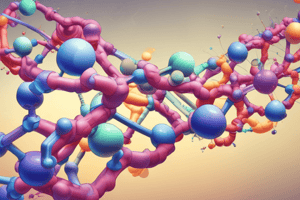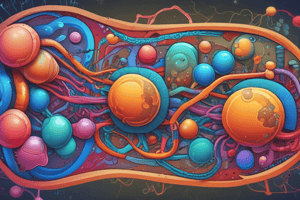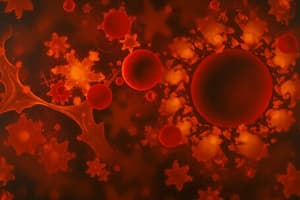Podcast
Questions and Answers
What is the primary function of Complex III in the electron transport chain?
What is the primary function of Complex III in the electron transport chain?
- To generate ATP directly
- To reduce oxygen into water
- To oxidize cytochrome c
- To translocate additional protons to the intermembrane space (correct)
In what form of oxidation state can heme iron in cytochrome c exist?
In what form of oxidation state can heme iron in cytochrome c exist?
- Both ferrous (Fe3+) and ferric (Fe2+) (correct)
- Neither ferrous nor ferric
- Only ferrous (Fe3+)
- Only ferric (Fe2+)
What is cytochrome c's role in the electron transport process?
What is cytochrome c's role in the electron transport process?
- It reduces ubiquinone to QH2
- It carries a single electron from the cytochrome bc1 complex to cytochrome oxidase (correct)
- It oxidizes oxygen to form water
- It generates protons in the matrix
Which of the following components are found in mammalian cytochrome oxidase?
Which of the following components are found in mammalian cytochrome oxidase?
How many protons are picked up from the matrix during the process of reducing one molecule of oxygen in Complex IV?
How many protons are picked up from the matrix during the process of reducing one molecule of oxygen in Complex IV?
What are the main reduced fuels that provide energy for ATP synthesis in cellular respiration?
What are the main reduced fuels that provide energy for ATP synthesis in cellular respiration?
What role do NADH and FADH2 play in oxidative phosphorylation?
What role do NADH and FADH2 play in oxidative phosphorylation?
How is the energy required to convert ADP to ATP in oxidative phosphorylation provided?
How is the energy required to convert ADP to ATP in oxidative phosphorylation provided?
Which of the following structures is NOT a component of a mitochondrion?
Which of the following structures is NOT a component of a mitochondrion?
What is the significance of the cristae within the inner membrane of a mitochondrion?
What is the significance of the cristae within the inner membrane of a mitochondrion?
Which theory explains the coupling of electron flow with proton movement to produce ATP?
Which theory explains the coupling of electron flow with proton movement to produce ATP?
Which component of the mitochondrion has the highest proton concentration during oxidative phosphorylation?
Which component of the mitochondrion has the highest proton concentration during oxidative phosphorylation?
Which mechanism primarily drives the transport of protons against the electrochemical gradient in mitochondria?
Which mechanism primarily drives the transport of protons against the electrochemical gradient in mitochondria?
What is the total amount of ATP produced using the Malate Shuttle?
What is the total amount of ATP produced using the Malate Shuttle?
Which compounds primarily regulate the rate of oxidative phosphorylation?
Which compounds primarily regulate the rate of oxidative phosphorylation?
How many ATP are produced from the oxidation of 2 NADH during glycolysis using the Malate Shuttle?
How many ATP are produced from the oxidation of 2 NADH during glycolysis using the Malate Shuttle?
Which of the following is a measure of the energy status of a cell?
Which of the following is a measure of the energy status of a cell?
What happens to the Mass-Action Ratio when energy is required in the cell?
What happens to the Mass-Action Ratio when energy is required in the cell?
What effect does high ATP concentration have on oxidative phosphorylation?
What effect does high ATP concentration have on oxidative phosphorylation?
How many ATP are generated from the Krebs cycle per molecule of acetyl-CoA?
How many ATP are generated from the Krebs cycle per molecule of acetyl-CoA?
How does the intracellular concentration of ADP influence respiration rates?
How does the intracellular concentration of ADP influence respiration rates?
What effect does the addition of cyanide (CN-) have on cellular respiration?
What effect does the addition of cyanide (CN-) have on cellular respiration?
Which molecule is a known uncoupler that allows respiration without ATP synthesis?
Which molecule is a known uncoupler that allows respiration without ATP synthesis?
What role does thermogenin play in brown adipose tissue?
What role does thermogenin play in brown adipose tissue?
What is the primary function of the Malate-Aspartate Shuttle?
What is the primary function of the Malate-Aspartate Shuttle?
How does valinomycin contribute to the process of ATP synthesis?
How does valinomycin contribute to the process of ATP synthesis?
What is a consequence of the action of oligomycin?
What is a consequence of the action of oligomycin?
What is the end result of transferring reducing equivalents to the mitochondrial matrix via the Glycerol-3-Phosphate Shuttle?
What is the end result of transferring reducing equivalents to the mitochondrial matrix via the Glycerol-3-Phosphate Shuttle?
What is required for the translocation of an additional proton per ATP synthesized?
What is required for the translocation of an additional proton per ATP synthesized?
What is primarily released from the mitochondria that triggers apoptosis?
What is primarily released from the mitochondria that triggers apoptosis?
Which of the following is correct regarding mitochondrial DNA?
Which of the following is correct regarding mitochondrial DNA?
What is a consequence of defects in oxidative phosphorylation?
What is a consequence of defects in oxidative phosphorylation?
Which process occurs in the mitochondria?
Which process occurs in the mitochondria?
What is the primary role of caspases in the cell?
What is the primary role of caspases in the cell?
Which of the following best describes the genetic coding of mitochondrial proteins?
Which of the following best describes the genetic coding of mitochondrial proteins?
What is the source of the proton motive force in mitochondria?
What is the source of the proton motive force in mitochondria?
Which of the following accurately describes the role of mitochondrial ribosomes?
Which of the following accurately describes the role of mitochondrial ribosomes?
What is the main role of Complex I in the electron transport chain?
What is the main role of Complex I in the electron transport chain?
How much energy is produced when transporting a pair of electrons from NADH to O2?
How much energy is produced when transporting a pair of electrons from NADH to O2?
What happens to the four protons transported by NADH when it interacts with Complex I?
What happens to the four protons transported by NADH when it interacts with Complex I?
What is one key characteristic of Succinate Dehydrogenase (Complex II)?
What is one key characteristic of Succinate Dehydrogenase (Complex II)?
What kind of reactions are involved in the transport of electrons through Complexes I to IV?
What kind of reactions are involved in the transport of electrons through Complexes I to IV?
What is a function of uncouplers in the electron transport chain?
What is a function of uncouplers in the electron transport chain?
What is the result of the energetic difference in redox potential during electron transfer?
What is the result of the energetic difference in redox potential during electron transfer?
How many protons are transported into the intermembrane space for each NADH molecule processed by Complex I?
How many protons are transported into the intermembrane space for each NADH molecule processed by Complex I?
Flashcards
Oxidative Phosphorylation
Oxidative Phosphorylation
Cellular process using energy from electron transfer to make ATP, the cell's energy currency.
Chemiosmotic Theory
Chemiosmotic Theory
Theory explaining ATP synthesis, where energy released from electron transport pumps protons against the gradient, creating a gradient used for ATP generation.
Electron Transport Chain
Electron Transport Chain
Sequence of protein complexes that transfer electrons to generate a proton gradient to make ATP.
ATP Synthesis
ATP Synthesis
Signup and view all the flashcards
Mitochondria
Mitochondria
Signup and view all the flashcards
Inner Mitochondrial Membrane
Inner Mitochondrial Membrane
Signup and view all the flashcards
Proton Gradient
Proton Gradient
Signup and view all the flashcards
Reduced Cofactors
Reduced Cofactors
Signup and view all the flashcards
Electron Transport Chain (ETC)
Electron Transport Chain (ETC)
Signup and view all the flashcards
Complex I (NADH dehydrogenase)
Complex I (NADH dehydrogenase)
Signup and view all the flashcards
Complex II (Succinate dehydrogenase)
Complex II (Succinate dehydrogenase)
Signup and view all the flashcards
Electron transfer inhibitors
Electron transfer inhibitors
Signup and view all the flashcards
Ubiquinone (Coenzyme Q)
Ubiquinone (Coenzyme Q)
Signup and view all the flashcards
ATP Production
ATP Production
Signup and view all the flashcards
Uncouplers
Uncouplers
Signup and view all the flashcards
Cytochrome c
Cytochrome c
Signup and view all the flashcards
Cytochrome oxidase (Complex IV)
Cytochrome oxidase (Complex IV)
Signup and view all the flashcards
Heme a and a3
Heme a and a3
Signup and view all the flashcards
CuA and CuB
CuA and CuB
Signup and view all the flashcards
Q-cycle
Q-cycle
Signup and view all the flashcards
Cyanide's effect on respiration
Cyanide's effect on respiration
Signup and view all the flashcards
Succinate and ATP synthesis
Succinate and ATP synthesis
Signup and view all the flashcards
Venturicidin/Oligomycin impact
Venturicidin/Oligomycin impact
Signup and view all the flashcards
What are uncouplers?
What are uncouplers?
Signup and view all the flashcards
DNP: Proton transport
DNP: Proton transport
Signup and view all the flashcards
Substrate availability
Substrate availability
Signup and view all the flashcards
Ionophores: Gradient disruptor
Ionophores: Gradient disruptor
Signup and view all the flashcards
ADP/Pi concentration
ADP/Pi concentration
Signup and view all the flashcards
Artificial gradient and ATP synthesis
Artificial gradient and ATP synthesis
Signup and view all the flashcards
Thermogenin: Brown fat's role
Thermogenin: Brown fat's role
Signup and view all the flashcards
Mass-Action Ratio
Mass-Action Ratio
Signup and view all the flashcards
Inhibition of OxPhos
Inhibition of OxPhos
Signup and view all the flashcards
NADH accumulation
NADH accumulation
Signup and view all the flashcards
Feedback Inhibition in Glycolysis
Feedback Inhibition in Glycolysis
Signup and view all the flashcards
Mitochondria's Role in Apoptosis
Mitochondria's Role in Apoptosis
Signup and view all the flashcards
Mitochondrial DNA
Mitochondrial DNA
Signup and view all the flashcards
Mitochondrial Protein Synthesis
Mitochondrial Protein Synthesis
Signup and view all the flashcards
Mitochondrial Mutations and Diabetes
Mitochondrial Mutations and Diabetes
Signup and view all the flashcards
Role of Cellular Respiration
Role of Cellular Respiration
Signup and view all the flashcards
Chemiosmotic Theory and Mitochondria
Chemiosmotic Theory and Mitochondria
Signup and view all the flashcards
Oxidative Phosphorylation: Main Processes
Oxidative Phosphorylation: Main Processes
Signup and view all the flashcards
Electron Carriers in Oxidative Phosphorylation
Electron Carriers in Oxidative Phosphorylation
Signup and view all the flashcards
Electron Transport Complexes
Electron Transport Complexes
Signup and view all the flashcards
Proton Motive Force
Proton Motive Force
Signup and view all the flashcards
Enzymes and ATP Synthesis
Enzymes and ATP Synthesis
Signup and view all the flashcards
Inhibitors of Electron Flow and ATP Synthesis
Inhibitors of Electron Flow and ATP Synthesis
Signup and view all the flashcards
Uncoupling Electron Flow and ATP Production
Uncoupling Electron Flow and ATP Production
Signup and view all the flashcards
Material Transfer In/Out of Mitochondria
Material Transfer In/Out of Mitochondria
Signup and view all the flashcards
Regulation of Oxidative Phosphorylation
Regulation of Oxidative Phosphorylation
Signup and view all the flashcards
Study Notes
Oxidative Phosphorylation Overview
- Oxidative phosphorylation is a metabolic process that uses energy from NADH and FADH₂ to produce ATP.
- Carbohydrates, lipids, and amino acids are the primary reduced fuels for the cell.
- Electrons from reduced fuel molecules are transferred to cofactors NADH or FADH₂.
Chemiosmotic Theory
- Energy needed to phosphorylate ADP is provided by the flow of protons down the electrochemical gradient.
- ∆G is related to ΔE = E₀ (e⁻ acceptor) – E₀ (e⁻ donor)
- Electrons are transferred from lower (more negative) to higher (more positive) reduction potential.
- Electrons released from redox processes, during electron transport transfer, power proton pumping against the electrochemical gradient.
Chemiosmotic Energy Coupling
- The proton gradient, necessary for ATP synthesis, is stably established across a membrane, impermeable to ions.
- Membranes in mitochondria
- inner membrane
- thylakoid membrane in chloroplasts
- plasma membrane in bacteria
- Proteins in the membrane couple 'downhill' flow of electrons with 'uphill' flow of protons across the membrane
- Another protein within the membrane couples the 'downhill' flow of protons to the phosphorylation of ADP.
Electron Carriers in the Electron Transport Chain
- Complexes in the electron transport chain contain multiple redox centers: flavin mononucleotide (FMN), and flavin adenine dinucleotide (FAD), cytochromes (a,b,c), and iron-sulfur clusters.
- Electron transfer order depends on reduction potential.
- These carriers have varying reduction potential (E'). Higher E' means greater tendency to accept electrons.
Coenzymes (FAD/FMN, NAD+/NADH, and FAD/FADH₂)
- Coenzymes associated with dehydrogenases transfer hydride ions (H⁻), consisting of one proton and two electrons.
- NAD(P)+/NAD(P)H, FMN/FMNH2, and FAD/FADH₂ are important electron carriers.
- FAD/FMN transfer hydrogen atoms (one proton and one electron)
Coenzyme Q (Ubiquinone)
- Lipid-soluble quinone, isoprenoid compound; readily accepts electrons from different redox-active compounds.
- Accepts two electrons; picks up two protons to become ubiquinol.
- Ubiquinol can diffuse freely in the membrane, carrying electrons with protons.
- Coenzyme Q transports electrons from complexes I and II to Complex III.
Cytochromes (a, b, and c)
- One-electron carriers based on Fe³⁺/Fe²⁺ redox systems.
- Cytochromes a, b, and c, differ by ring additions and substitutions, which affect their redox properties.
Iron-Sulfur Proteins
- One-electron carriers based on Fe³⁺/Fe²⁺ redox system.
- Iron ions coordinated by cysteine residues in the protein.
- Iron-sulfur clusters contain equal numbers of iron and sulfur atoms.
Chemiosmotic Model for ATP Synthesis
- Electron transport through complexes I-IV establishes a proton-motive force (PMF).
- The energy of PMF drives ATP synthesis via ATP synthase.
- Includes the flow of electrons creates a concentration gradient of protons established across the membrane.
Mitochondrial ATP Synthase Complex
- Consists of two functional subunits (Fo and F₁)
- Fo is an integral membrane complex that transports protons from the intermembrane space to the matrix.
- F₁ is a soluble complex in the matrix that hydrolyzes ATP.
- Dimers, can exist in 3 different conformations (open, loose and tight).
Synthesis of ATP in ATP Synthase
- Translocation of 3 protons fuels synthesis of one ATP molecule
- Electrochemical energy generated through proton concentration gradients drives ATP synthesis.
Inhibitors and Uncouplers
- Inhibitors block electron transport (e.g., cyanide, antimycin A).
- Inhibitors block ATP synthase (e.g., oligomycin, venturicidin).
- Uncouplers allow respiration to continue without ATP synthesis (e.g., dinitrophenol, valinomycin).
- Uncouplers bypass H⁺ flow through the ATPase.
Mitochondrial Transport of Species
- Translocation of a fourth proton per ATP is required.
- This allows cotransport of substrates into and products out of the matrix.
- Adenine nucleotide translocase and phosphate translocase are important transport proteins in the inner mitochondrial membrane.
Malate-Aspartate Shuttle
- Transports reducing equivalents (NADH) from the cytosol into the mitochondrial matrix.
- This shuttle is important in liver, kidneys, and heart.
Glycerol-3-Phosphate Shuttle
- An alternative method used by skeletal muscle and brain tissues to transport reducing equivalents.
- Transfers electrons through FADH₂, reducing NADH production efficiency by one ATP generated per NADH molecule.
Oxidation of Glucose
- Oxidation of Glucose yields a total of 38 ATP molecules with the Malate Shuttle. With Glycerol Phosphate Shuttle the yield is 36 ATP.
Regulation of Oxidative Phosphorylation
- Primarily regulated by substrate availability (NADH and ADP/Pi).
- The rate of O₂ consumption and ATP synthesis is regulated by the intracellular concentration of ADP.
- High ATP levels inhibit oxidative phosphorylation.
Mitochondria and Apoptosis
- Mitochondrial membrane integrity loss during apoptosis (programmed cell death) releases cytochrome c that activates caspase proteases.
Mitochondrial Genetics
- Mitochondrial DNA (mtDNA) is circular and carries 37 genes.
- mtDNA encodes rRNA, tRNA molecules, and enzymes critical to oxidative phosphorylation.
- Mitochondria have their own ribosomes but rely on nuclear DNA for most proteins.
- mtDNA inheritance is maternal.
- Mutations in mitochondrial DNA can produce various diseases.
Mitochondrial Mutations and Diabetes
- Defects in oxidative phosphorylation can reduce ATP production.
- This causes impaired insulin release from pancreatic beta cells which leads to a rare form of diabetes.
Studying That Suits You
Use AI to generate personalized quizzes and flashcards to suit your learning preferences.




